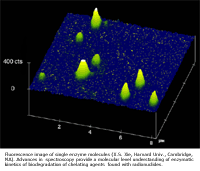
 Goal
Goal
Research in the Biomolecular Sciences and Engineering element will provide a knowledge base, at the biomolecular level, of the processes leading to the immobilization of metals and radionuclides by subsurface microorganisms. The primary goal is to understand the genetic, biochemical, and regulatory processes that mediate biotransformation of metals and radionuclides. Characterization of genes, gene products, and genetic regulatory networks associated with these biotransformations is key to this understanding. Secondary goals include 1) understanding, at a molecular level, the process of lateral transfers between microbes of genes involved in biotransformation of metals and radionuclides; 2) developing novel technologies to provide insights into biomolecular mechanisms of metal and radionuclide biotransformation (see Figure 5); and 3) developing approaches to manipulate pathways and enzyme systems that mediate these transformations. The last goal focuses on the potential to engineer microbes at a genetic level to improve their ability to immobilize metals and radionuclides. This research will be important should the option of bioaugmentation be pursued.
R&D Challenges
DOE subsurface sites encompass a wide range of environments, with a diversity of microbial communities, consortia, and contaminants. One of the first challenges in this element is to select microbes for biomolecular studies that are, in fact, active members of subsurface microbial communities. A second, even more difficult challenge is to extrapolate laboratory findings on pure cultures under controlled laboratory conditions to complex in situ environmental conditions. This extrapolation is especially critical in studying gene expression, which may be modified by changes in local cellular environments in the subsurface. A third challenge for scientists in this element is to take full advantage of genomic and other data, derived from the DOE Microbial Genome Program, that is now becoming available through the DOE on subsurface microorganisms such as Geobacter, Shewanella, and Desulfovibrio.
R&D Initiatives: Current Status
Research is under way to identify and characterize novel genes, gene clusters, promoters, proteins, and pathways that are 1) involved in the biotransformation of metals and radionuclides, and/or 2) promote survival of microorganisms in the presence of metals and radionuclides. Additionally, research is in progress to identify and characterize the transfer of genes and chromosomal segments between organisms that can influence processes involved in bioremediation of metals and radionuclides. Finally, research is under way to engineer or enhance bioremedial enzyme pathways, using genes from microbes able to survive and compete effectively in environments contaminated by metals and/or radionuclides.
R&D Initiative: 3 Year Targets
Within the next three years, research will focus on understanding the regulation of genes that have been identified to be important in 1) the transformation of metals and radionuclides by naturally occurring microorganisms in contaminated subsurface environments, and 2) the survival of microorganisms in the presence of potentially toxic levels of metals and radionuclides. The effects of key environmental parameters on regulation and expression of these genes will be explored. Studies will also begin to elucidate the biomolecular mechanisms involved in lateral gene transfer in subsurface microbial communities. Such studies will improve the ability to predict and to manipulate the activities of microbes in situ, particularly in an in situ immobilization scenario.
R&D Initiatives: 7-10 Year Targets
Within seven to ten years, enzyme systems and pathways that mediate, regulate, and enhance bioremediation processes in natural microbial communities will be characterized in sufficient detail to permit deliberate in situ manipulation of naturally occurring microorganisms at the FRC. Techniques for assessing the character, frequency, lability, and stability of lateral gene transfers will be sufficiently advanced to allow in situ measurements of natural microbial communities at the NABIR FRC.